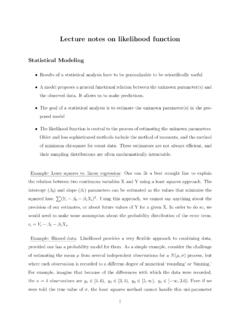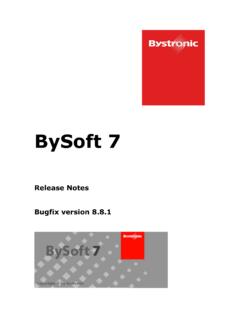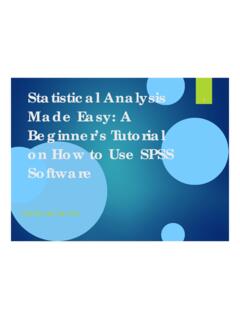Transcription of How to write a good codebook - Faculty of Medicine and ...
1 codebook cookbook A guide to writing a good codebook for data analysis projects in Medicine 1. Introduction Writing a codebook is an important step in the management of any data analysis project. The codebook will serve as a reference for the clinical team; it will help newcomers to the project to rapidly have a flavor of what is at stake and will serve as a communication tool with the statistical unit. Indeed, when comes time to perform statistical analyses on your data, the statistician will be grateful to have a codebook that is readily usable, that is, a codebook that is easy to turn into code for whichever statistical analysis package he/she will use (SAS, R, Stata, or other). 2. Data preparation Whether you enter data in a spreadsheet such as Excel (as is currently popular in biomedical research) or a database program such as Access, there is much freedom in the way data can be entered.
2 A few rules, however, should be followed, to make both the data entry and subsequent data analysis as smooth as possible. A specific example will be presented in Section 3, but first let s look at a few general suggestions. Variables names A unique, unambiguous name should be given to each variable. Variables names MUST consist of one string only, consisting of letters and when useful numbers and underscores ( _ ). Spaces are not allowed in variables names in most statistical programs, even if data entry programs like Excel or Access will allow this. It is good practice to enter variables names at the top of each column. Variables names should be long enough to be meaningful, but short enough to be easy to handle; variables labels (below) are the place to clarify what is coded in each variable more substantially.
3 Variables labels A label is a description of the variable, such as a textual description or a reference to the question number, if the item arises from a questionnaire. It is important to include a descriptive variable label for each variable in the file. In practice, these can be added to the existing data base or as a listing in a text file separate from your data file. Variables labels are important not only for the statistician to understand the contents of each data item, but also to the researchers, as the labels will facilitate understanding of the outputs of the statistical analysis, which they must interpret. Examples of variable labels will be presented in Section Variables codes Each categorical variable should have a set of exhaustive, mutually exclusive codes.
4 These codes should be thoroughly documented in the codebook . Where possible, standard data codes should be used ( 0=no, 1=yes for yes/no variables): the use of such standards facilitates the comparison of results across variables, or even across studies. Examples of variable codes (sometimes called value labels) will be presented in Section Variables formats Data should be reduced to numeric codes whenever possible. This avoids the occurrence of typographical errors in entering literal answers, leading to misinterpretation of two equivalent answers as being different, and above all greatly facilitates the use of the variables in statistical models, as most statistical packages cannot use character variables (that is, variables taking alphanumeric values, gender=F or M) directly in statistical models.
5 (In fact, the alphanumeric variables can be used, but only after some preprocessing that can be time consuming and hence expensive.) Character entries should be used for descriptive purposes only, in comment variables reason for withdrawal from experiment, reason for non-adherence to medication, etc and even in these cases, only when the number of possible answers is large, so that creating numeric codes for all possibilities becomes too cumbersome. If for some reason you still prefer to enter alphanumeric values (we can imagine that sometimes it saves some time and/or is less error-prone at data entry), we will still suggest a few hints in Section 5 to reduce problems further down the line, at the statistician s end. missing data In practice, missing data almost always occur in clinical projects; they can arise from many sources, such as refusal to answer, omission, missing by design, etc.
6 The coding of missing data often does not receive special attention, which is often benign; indeed, cells left empty in Excel spreadsheets, for example, will be interpreted as missing data by most statistical programs. It is sometimes important however either in data analysis or when writing reports to be able to distinguish between different types of missing data, and that will require some coding. Furthermore, specifically coding missing values in a data bank makes it clear that the data item is truly missing , as opposed to an omission by the data entry person, which is unfortunate but happens in practice; if true missing values were coded, identifying data entry omissions will be trivial and going back to charts (or questionnaires) when possible will be a foreseeable option to minimize the amount of missing information.
7 Section will suggest a way to code missing values. Date variables Date variables are often problematic, as there is no uniform standard for date formats. Therefore, it is important to choose a standard and keep the same date format for each record (subject, patient) for all date variables in the project. In Section , we will suggest a sensible and easy to use date format. 3. Entering your codebook through Excel spreadsheets Very often, statisticians are sent data files that contain all the information listed in Section 2, but either through inconvenient codebooks ( written in Word tables that are hard to access electronically by other programs, leading to cut and paste coding which needlessly duplicates efforts) or data file columns headers.
8 Even though all the information necessary for data coding and analysis may be included, the information is so sparse and not easily accessed that it is not readily usable. It is much more efficient to include all the necessary information in a format that can be read in an automated way. The examples in Section will illustrate a programmer-friendly codebook that remains easy to prepare. For example, when SAS perhaps the most commonly used statistical package for data coding reads an Excel file and tries to obtain the variable names from the top row of the file, it expects a single string (no space, no bracket, no equal sign: nothing but a word!); consequently, it converts the content of top row cells by replacing unacceptable characters into underscores, shortens lengthy names and adds numeric suffixes when necessary to keep them unique; this often results in non-optimal and often hard to comprehend variables names, as shown in the examples in Table 1.
9 Original Excel column header Variable name, when converted by SAS ETHORIG (1=Caucasian) 2=Black 3=Asian 4=Natives ETHORIG__1_Caucasian__2_Black_3_ (total damage score) SLICMAX_LM__total_damage_score_ Table 1. Choosing friendly variables names. The two shorter and yet meaningful alternatives ethorig and SlicMax_LM would have been accepted by SAS without any changes, meaning that the original codebook could be used when deciphering the outputs from the analyses. These examples illustrate why keeping variable names simple is always a good idea! The additional bits of information ( codes 1=Caucasian, 2=Black, etc. for the first variable, and text total damage score for the second) should not be entered in variable names, but rather belong in value labels and variable labels, respectively, as will be illustrated shortly.
10 Labels Variable labels Figure 1. Variables names, labels and formats. The variable labels section (or maybe sheet, if you use Excel and prefer to keep all information in a single file) of your codebook should contain the following three bits of information: variables names (identical to that used in the data entry page), format names and variable labels (see columns A, B and C, in Figure 1). Feel free to enter additional information in subsequent columns ( measurement units though measurement units could also be included in variable label, valid ranges for data, values for missing and inapplicable data, etc.) Categorical variables that were entered with numeric codes should be identified as such through the means of an associated format name (column B, in Figure 1).









